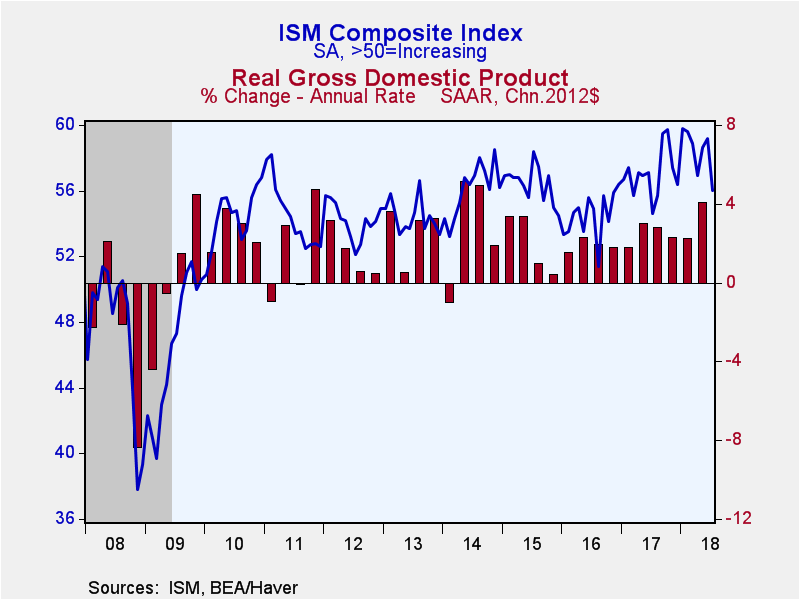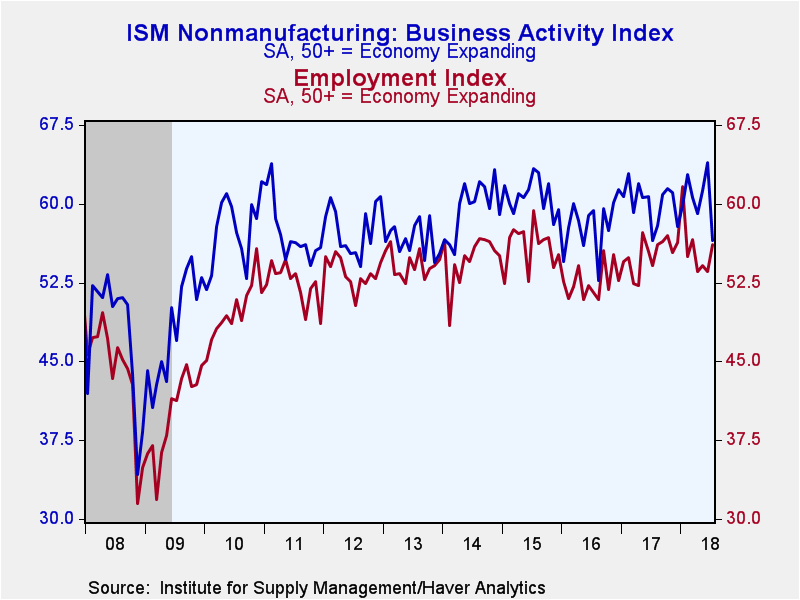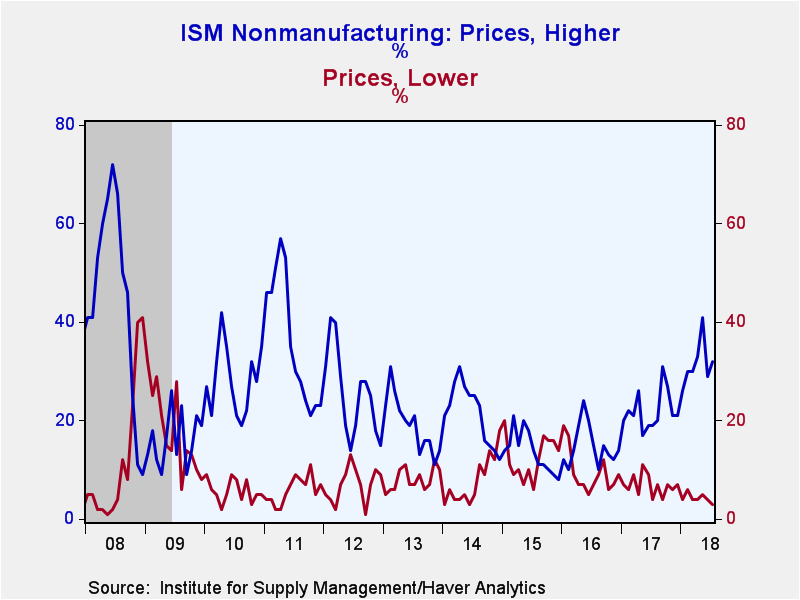 Global| Aug 03 2018
Global| Aug 03 2018U.S. ISM Nonmanufacturing Index Weakens
Summary
The Composite Index of Nonmanufacturing Sector Activity from the Institute for Supply Management (ISM) declined to a still healthy 55.7 in July from 59.1 in June. The Action Economics Forecast Survey expected a reading of 58.8 for [...]
The Composite Index of Nonmanufacturing Sector Activity from the Institute for Supply Management (ISM) declined to a still healthy 55.7 in July from 59.1 in June. The Action Economics Forecast Survey expected a reading of 58.8 for last month. The ISM data are diffusion indexes where readings above 50 indicate expansion.
Haver Analytics constructs a Composite Index using the nonmanufacturing ISM index and the ISM factory sector measure released Wednesday. This composite decreased to 56.0 from 59.2, but is still up from the 54.6 reading last July. During the last ten years, there has been a 71% correlation between this index and the quarter-on-quarter change in real GDP.
Four out of five of the component series in the non-manufacturing index declined. The only exception was employment which rose 56.1 from 53.6. The business activity reading fell to 56.5 from June's cycle-high of 63.9. New orders dropped to 57.0 from 63.2, while supplier deliveries decreased to 53.0 from 55.5, indicating a slower pace of order fulfillment.
During the last ten years, there has been an 88% correlation between the ISM nonmanufacturing sector jobs index and the month-on-month (m/m) change in private service plus construction sector payrolls. Twenty-eight percent (not seasonally adjusted - nsa) of industries reported a rising jobs level while 12% indicated a decline (both of these readings edged down by one percentage point).
The prices paid index rose to 63.4 in July from 60.7, though is still below last September's cycle peak of 65.9. An increased 32% (nsa) of firms reported paying higher prices while just three percent of firms paid less, the lowest in four years.
Among the other detail indexes, which are not seasonally adjusted, the export order series declined modestly m/m. This series has been range-bound for the last year. The import index edged up, while the order backlog index continued its retreat from May's record high.
The ISM figures are available in Haver's USECON database, with additional detail in the SURVEYS database. The expectations figure from Action Economics is in the AS1REPNA database.
| ISM Nonmanufacturing Survey (SA) | Jul | Jun | May | Jul'17 | 2017 | 2016 | 2015 |
|---|---|---|---|---|---|---|---|
| Composite Diffusion Index | 55.7 | 59.1 | 58.6 | 54.3 | 57.0 | 54.9 | 57.1 |
| Business Activity | 56.5 | 63.9 | 61.3 | 56.5 | 60.1 | 58.0 | 60.8 |
| New Orders | 57.0 | 63.2 | 60.5 | 55.7 | 59.3 | 57.5 | 59.2 |
| Employment | 56.1 | 53.6 | 54.1 | 54.1 | 55.2 | 52.6 | 56.0 |
| Supplier Deliveries (NSA) | 53.0 | 55.5 | 58.5 | 51.0 | 53.2 | 51.5 | 52.5 |
| Prices Index | 63.4 | 60.7 | 64.3 | 56.4 | 57.7 | 52.6 | 50.6 |
Gerald D. Cohen
AuthorMore in Author Profile »Gerald Cohen provides strategic vision and leadership of the translational economic research and policy initiatives at the Kenan Institute of Private Enterprise.
He has worked in both the public and private sectors focusing on the intersection between financial markets and economic fundamentals. He was a Senior Economist at Haver Analytics from January 2019 to February 2021. During the Obama Administration Gerald was Deputy Assistant Secretary for Macroeconomic Analysis at the U.S. Department of Treasury where he helped formulate and evaluate the impact of policy proposals on the U.S. economy. Prior to Treasury, he co-managed a global macro fund at Ziff Brothers Investments.
Gerald holds a bachelor’s of science from the Massachusetts Institute of Technology and a Ph.D. in Economics from Harvard University and is a contributing author to 30-Second Money as well as a co-author of Political Cycles and the Macroeconomy.









